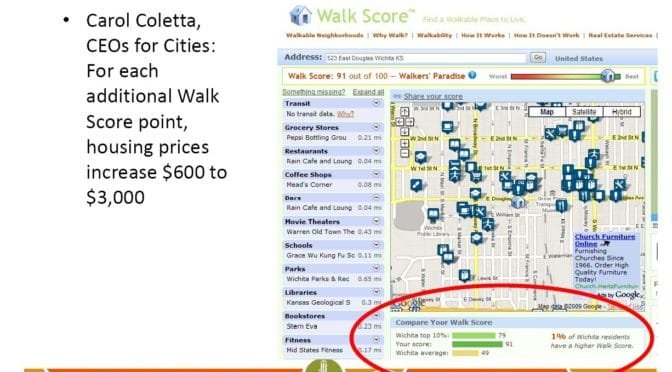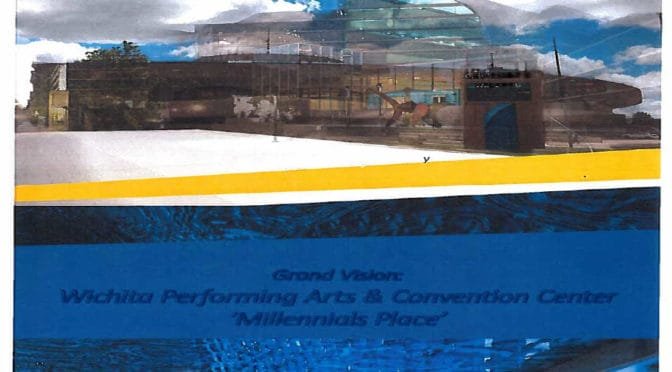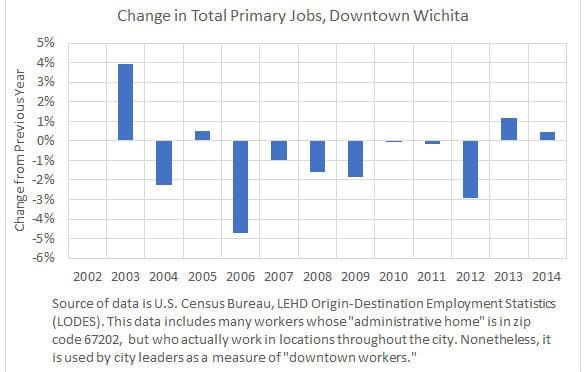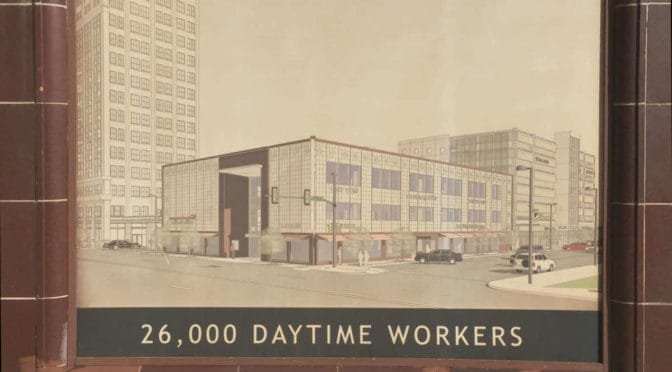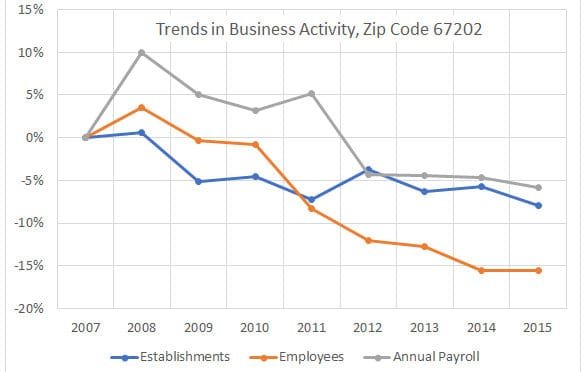The City of Wichita will soon be flooded with data regarding downtown convention and performing arts facilities. Past experience should warn us to be skeptical.
Goody Clancy, a planning firm hired by Wichita Downtown Development Corporation, told a Wichita audience that the planning effort for downtown Wichita is grounded in data and hard analysis.1
But at least some of the data Goody Clancy used turned out to be total nonsense.
Specifically, Goody Clancy presented Walk Score data for downtown Wichita. Walk Score is purported to represent a measure of walkability of a location in a city. Walkability is a key design element of the master plan Goody Clancy has developed for downtown Wichita. David Dixon, who leads Goody Clancy’s Planning and Urban Design division, used Walk Score in a presentation delivered in Wichita.
Walk Score is not a project of Goody Clancy, as far as I know, and David Dixon is not responsible for the accuracy or reliability of the Walk Score website. But he presented it and relied on it as an example of the data-driven approach that Goody Clancy takes.
For example, the score for 525 E. Douglas, the block the Eaton Hotel is in and mentioned by Dixon as a walkable area, scored 91, which means it is a “walker’s paradise,” according to the Walk Score website.

For a nearby library, it listed Robert F. Walters Digital Library, which is a specialized geological library costing $1,500 per year to use — over the internet.
For a drug store, it listed Rx Doctor’s Choice, which is a company selling oral chelation treatments by mail order. It’s nothing at all like a general-purpose drug store. One of those is nowhere nearby.
There were other claimed amenities where the data is just as bad. But as Larry Weber, then chairman of the Wichita Downtown Development Corporation told me, Walk Score has been updated. I should no longer be concerned with the credibility of this data, he said.
He was correct — partially. Walk Score was updated, but we should still be concerned about the quality of the data. Now for the same location the walk score is 85, which is considered “very walkable.” The “grocery store” is no longer the Pepsi Bottling Group. It’s now “Market Place,” whose address is given as 155 N. Market St #220.
If anyone would ever happen to stroll by that location, they would find that address — 155 N. Market number 220 — is the management office for an office building whose name is Market Place. It’s not a grocery store. It’s an office. So I became even more concerned about the credibility of this data and the fact that Goody Clancy relied on it. I was also concerned that Weber thinks thought this was an improvement, and that he felt I should not be concerned.
David Dixon and Goody Clancy did not create the Walk Score data. But he and his planning company presented it to Wichitans as an example of the data-driven, market-oriented approach to planning that they use.
But anyone who relies on the evidence Dixon and Goody Clancy presented would surely be confused unless they investigated the area on their own.
And since this reliance on Walk Score was made after Goody Clancy had spent considerable time in Wichita, the fact that someone there could not immediately recognize how utterly bogus the data is: That should give us cause for concern that the entire planning process is based on similar shoddy data and analysis. We also ought to be concerned that no one at WDDC or city hall looked closely enough at this data to realize its total lack of correspondence to reality.
When I presented these concerns to the Wichita Metropolitan Area Planning Commission in 2010, Scott Knebel, a member of the city’s planning staff who is the city’s point man on downtown planning, address the concerns raised by me. He said, “In terms of the Walk Score, I suspect Mr. Weeks is absolutely right, it probably is a relatively flawed measurement of Walk Score.” He added that the measurement is probably flawed everywhere, downtown and elsewhere. He said that Goody Clancy used it “as an illustration of the importance of walkability in an urban area.”
An isolated incident, long ago?
Seven years later, should we be concerned about this incident?
If that was the only example of low-quality and deceptive data, we could say sure, that was long ago. Let’s forget this and go forward. Our city leaders are smarter now.
Except they’re not.
The oft-cited claim of 26,000 workers in downtown Wichita is another example of misuse of data, and in a very big way. It comes from the U.S. Census Bureau. This particular data set counts all Wichita school district employees as downtown workers, even though nearly all work at locations scattered throughout the city.2
If we accept this data as meaning what WDDC and the city says it means, we’d have to believe that 7,740 people work in a one square block area from First to Second Streets, and Wichita to Water Streets. That block is mostly surface parking, but it does hold the administrative offices of the Wichita school district. So all school district employees are counted as working in this block.
There is similar problem in another block. All City of Wichita employees are treated as though they work at city hall. But they don’t.
Does any of this matter? It ought to matter. The planners tell us they use data to make decisions. This week the city council decided to hire a consulting firm to investigate the feasibility of a refurbished or new convention center and performing arts center. I’m sure much data will be presented. Based on our past experience, we’ll have to carefully examine data for appropriate usage.
—
Notes
- Weeks, Bob. Goody Clancy market findings presented to Wichita audience. Available at https://wichitaliberty.org/wichita-government/goody-clancy-market-findings-presented-to-wichita-audience/. ↩
- Weeks, Bob. Downtown Wichita jobs, sort of. The claim of 26,000 workers in downtown Wichita is based on misuse of data so blatant it can be described only as malpractice. Available at https://wichitaliberty.org/wichita-government/downtown-wichita-jobs/. ↩
